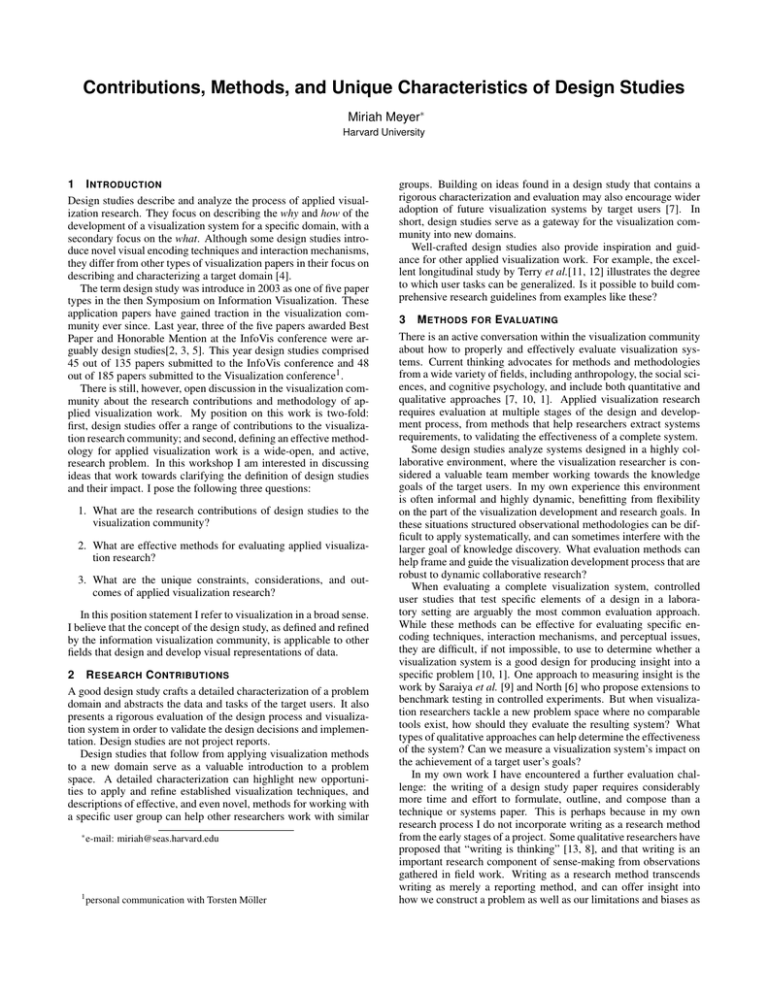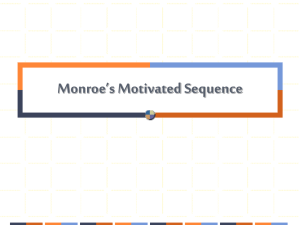Contributions, Methods, and Unique Characteristics of Design Studies Miriah Meyer
advertisement

Contributions, Methods, and Unique Characteristics of Design Studies Miriah Meyer∗ Harvard University 1 I NTRODUCTION Design studies describe and analyze the process of applied visualization research. They focus on describing the why and how of the development of a visualization system for a specific domain, with a secondary focus on the what. Although some design studies introduce novel visual encoding techniques and interaction mechanisms, they differ from other types of visualization papers in their focus on describing and characterizing a target domain [4]. The term design study was introduce in 2003 as one of five paper types in the then Symposium on Information Visualization. These application papers have gained traction in the visualization community ever since. Last year, three of the five papers awarded Best Paper and Honorable Mention at the InfoVis conference were arguably design studies[2, 3, 5]. This year design studies comprised 45 out of 135 papers submitted to the InfoVis conference and 48 out of 185 papers submitted to the Visualization conference1 . There is still, however, open discussion in the visualization community about the research contributions and methodology of applied visualization work. My position on this work is two-fold: first, design studies offer a range of contributions to the visualization research community; and second, defining an effective methodology for applied visualization work is a wide-open, and active, research problem. In this workshop I am interested in discussing ideas that work towards clarifying the definition of design studies and their impact. I pose the following three questions: 1. What are the research contributions of design studies to the visualization community? 2. What are effective methods for evaluating applied visualization research? 3. What are the unique constraints, considerations, and outcomes of applied visualization research? In this position statement I refer to visualization in a broad sense. I believe that the concept of the design study, as defined and refined by the information visualization community, is applicable to other fields that design and develop visual representations of data. 2 R ESEARCH C ONTRIBUTIONS A good design study crafts a detailed characterization of a problem domain and abstracts the data and tasks of the target users. It also presents a rigorous evaluation of the design process and visualization system in order to validate the design decisions and implementation. Design studies are not project reports. Design studies that follow from applying visualization methods to a new domain serve as a valuable introduction to a problem space. A detailed characterization can highlight new opportunities to apply and refine established visualization techniques, and descriptions of effective, and even novel, methods for working with a specific user group can help other researchers work with similar ∗ e-mail: miriah@seas.harvard.edu 1 personal communication with Torsten Möller groups. Building on ideas found in a design study that contains a rigorous characterization and evaluation may also encourage wider adoption of future visualization systems by target users [7]. In short, design studies serve as a gateway for the visualization community into new domains. Well-crafted design studies also provide inspiration and guidance for other applied visualization work. For example, the excellent longitudinal study by Terry et al.[11, 12] illustrates the degree to which user tasks can be generalized. Is it possible to build comprehensive research guidelines from examples like these? 3 M ETHODS FOR E VALUATING There is an active conversation within the visualization community about how to properly and effectively evaluate visualization systems. Current thinking advocates for methods and methodologies from a wide variety of fields, including anthropology, the social sciences, and cognitive psychology, and include both quantitative and qualitative approaches [7, 10, 1]. Applied visualization research requires evaluation at multiple stages of the design and development process, from methods that help researchers extract systems requirements, to validating the effectiveness of a complete system. Some design studies analyze systems designed in a highly collaborative environment, where the visualization researcher is considered a valuable team member working towards the knowledge goals of the target users. In my own experience this environment is often informal and highly dynamic, benefitting from flexibility on the part of the visualization development and research goals. In these situations structured observational methodologies can be difficult to apply systematically, and can sometimes interfere with the larger goal of knowledge discovery. What evaluation methods can help frame and guide the visualization development process that are robust to dynamic collaborative research? When evaluating a complete visualization system, controlled user studies that test specific elements of a design in a laboratory setting are arguably the most common evaluation approach. While these methods can be effective for evaluating specific encoding techniques, interaction mechanisms, and perceptual issues, they are difficult, if not impossible, to use to determine whether a visualization system is a good design for producing insight into a specific problem [10, 1]. One approach to measuring insight is the work by Saraiya et al. [9] and North [6] who propose extensions to benchmark testing in controlled experiments. But when visualization researchers tackle a new problem space where no comparable tools exist, how should they evaluate the resulting system? What types of qualitative approaches can help determine the effectiveness of the system? Can we measure a visualization system’s impact on the achievement of a target user’s goals? In my own work I have encountered a further evaluation challenge: the writing of a design study paper requires considerably more time and effort to formulate, outline, and compose than a technique or systems paper. This is perhaps because in my own research process I do not incorporate writing as a research method from the early stages of a project. Some qualitative researchers have proposed that “writing is thinking” [13, 8], and that writing is an important research component of sense-making from observations gathered in field work. Writing as a research method transcends writing as merely a reporting method, and can offer insight into how we construct a problem as well as our limitations and biases as researchers [8]. Analyzing the why and how of a visualization system is at the heart of a design study, and thus incorporating writing methods from the early stages of research could help make these issues salient. 4 U NIQUENESS OF A PPLIED V ISUALIZATION R ESEARCH Other fields of computer science incorporate applied research into their conferences and publications. For example, the SIGCHI conference has a paper type called Experience which describes how “HCI methods, theory, or tools were applied to the design or development of an HCI artifact”2 . Can we utilize the requirements and expectations from these fields to further refine the goals of visualization design studies? On the other hand, it is also interesting to contemplate how applied visualization research differs from that of other fields. Are there unique considerations for visualization design that must be considered when choosing evaluation methods? Do established evaluation methodologies need to be modified for effective application to visualization research? What makes the goals of visualization different from other computer science fields when it comes to applied research? Trying to discover the unique considerations of our field could lead to improved methods for design and evaluation, whether or not this uniqueness is found to exist. 5 C ONCLUSION In this position statement I advocate for the contribution of design studies to the visualization research community, and also for the continued investigation into how to define and refine our methods for evaluating and framing applied visualization research. I am excited to hear the ideas and input from other participants in the workshop to the questions and opinions I pose in this statement. ACKNOWLEDGEMENTS I wish to thank Tamara Munzner for all of the insightful and detailed conversations around the topic of design studies that led to the writing of this position statement. R EFERENCES [1] S. Carpendale. Evaluating information visualizations. In A. Kerren, J. Stasko, J.-D. Fekete, and C. North, editors, Information Visualization, volume 4950 of Lecture Notes in Computer Science, pages 19– 45. Springer Berlin / Heidelberg, 2008. [2] Z. Liu, J. Stasko, and T. Sullivan. Selltrend: Inter-attribute visual analysis of temporal transaction data. IEEE Transactions on Visualization and Computer Graphics, 15:1025–1032, 2009. [3] M. Meyer, T. Munzner, and H. Pfister. MizBee: A multiscale synteny browser. IEEE Trans. Visualization and Computer Graphics (Proc. InfoVis 2009), 15(6):897–904, 2009. [4] T. Munzner. Process and pitfalls in writing information visualization research papers. pages 134–153, 2008. [5] C. B. Nielsen, S. D. Jackman, I. Birol, and S. J. Jones. Abyss-explorer: Visualizing genome sequence assemblies. IEEE Transactions on Visualization and Computer Graphics, 15:881–888, 2009. [6] C. North. Toward measuring visualization insight. Computer Graphics and Applications, IEEE, 26(3):6 –9, may. 2006. [7] C. Plaisant. The challenge of information visualization evaluation. In AVI ’04: Proceedings of the working conference on Advanced visual interfaces, pages 109–116, New York, NY, USA, 2004. ACM. [8] L. Richardson and E. A. S. Pierre. Writing: A method for inquiry. In N. Denzin and Y. Lincoln, editors, Handbook of Qualitative Research, chapter 38, pages 959–978. Sage Publications, 3rd edition, 2005. [9] P. Saraiya, C. North, and K. Duca. An insight-based methodology for evaluating bioinformatics visualizations. IEEE Trans. Visualization and Computer Graphics, 11(4):443–456, 2005. 2 http://www.sigchi.org/chi2010/authors/ selecting-contribution-type.html [10] B. Shneiderman and C. Plaisant. Strategies for evaluating information visualization tools: multi-dimensional in-depth long-term case studies. In BELIV ’06: Proceedings of the 2006 AVI workshop on BEyond time and errors, pages 1–7, New York, NY, USA, 2006. ACM. [11] M. Terry and E. D. Mynatt. Side views: persistent, on-demand previews for open-ended tasks. In UIST ’02: Proceedings of the 15th annual ACM symposium on User interface software and technology, pages 71–80, New York, NY, USA, 2002. ACM. [12] M. Terry, E. D. Mynatt, K. Nakakoji, and Y. Yamamoto. Variation in element and action: supporting simultaneous development of alternative solutions. In CHI ’04: Proceedings of the SIGCHI conference on Human factors in computing systems, pages 711–718, New York, NY, USA, 2004. ACM. [13] H. Wolcott. Writing up qualitative research. Sage Publications, 3rd edition, 2009.



